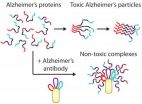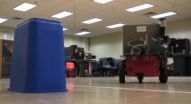(Press-News.org) How effective is the German mammography screening program? This is the question examined by Oliver Heidinger of the Epidemiological Cancer Registry North Rhine–Westphalia and his co-authors in the first study on this subject in Germany, in Deutsches Ärzteblatt International (Dtsch Arztebl Int 2012; 109(46): 781-7).
To answer it, the authors have used the interval cancer rate as an indicator. Interval cancers are tumors found more or less by chance between two screenings. In approximately 880 000 women from North Rhine–Westphalia who had taken part in mammography screening for the first time between 2005 and 2008 and had received negative test results, the authors examined whether breast cancer occurred in the following 24 months. It was shown to occur in approximately 2000 women. This corresponds to a rate of 0.23%, a result that is absolutely comparable with similar international studies.
However, the authors also noticed another result in their follow-up research: 40% of all malignant breast tumors of size T2 to T4 (i.e. ranging from at least 2 cm to more than 5 cm) detected in the study participants during the observation period proved to be interval cancers. Further research is needed to explain this phenomenon.
###
http://www.aerzteblatt.de/pdf.asp?id=132482
Cancer screening: The efficacy of mammography screening
2012-12-03
ELSE PRESS RELEASES FROM THIS DATE:
New 'pipeline' device offers new option for difficult-to-treat aneurysms
2012-12-03
Philadelphia, Pa. (December 3, 2012) – A new technology called the Pipeline embolization device (PED) shows encouraging results in patients with certain types of difficult-to-treat brain aneurysms, reports the December issue of Neurosurgery, official journal of the Congress of Neurological Surgeons. The journal is published by Lippincott Williams & Wilkins, a part of Wolters Kluwer Health.
Data collected since the PED was approved for marketing show generally good results in "real world" clinical practice. However, the report raises concerns about fatal bleeding and other ...
Novel antibodies for combating Alzheimer's and Parkinson's disease
2012-12-03
Troy, N.Y. – Antibodies developed by researchers at Rensselaer Polytechnic Institute are unusually effective at preventing the formation of toxic protein particles linked to Alzheimer's disease and Parkinson's disease, as well as Type 2 diabetes, according to a new study.
The onset of these devastating diseases is associated with the inappropriate clumping of proteins into particles that are harmful to cells in the brain (Alzheimer's disease and Parkinson's disease) and pancreas (Type 2 diabetes). Antibodies, which are commonly used by the immune system to target foreign ...
Awareness is key to preventing heat- and cold-induced athletic injuries
2012-12-03
ROSEMONT, Ill.—Extreme heat or cold can cause dangerous and potentially fatal side effects in athletes. A literature review appearing in the December 2012 issue of the Journal of the American Academy of Orthopaedic Surgeons (JAAOS) provides an overview of the risk factors, signs and symptoms, and management of various conditions related to excessive heat and cold exposure.
"Both extreme heat and cold can be challenging for athletes during training and competition," said lead study author Benjamin Noonan, MD, MS. "One role of the team physician is to educate coaches and ...
Squirrels and birds inspire researchers to create deceptive robots
2012-12-03
Using deceptive behavioral patterns of squirrels and birds, researchers at the Georgia Institute of Technology have developed robots that are able to deceive each other. The research is funded by the Office of Naval Research and is led by Professor Ronald Arkin, who suggests the applications could be implemented by the military in the future. The research is highlighted in the November/December 2012 edition of IEEE Intelligent Systems.
Arkin and his team learned by reviewing biological research results that squirrels gather acorns and store them in specific locations. ...
College students report low flu vaccine rate
2012-12-03
WINSTON-SALEM, N.C. – Dec. 3, 2012 – College football and basketball games may provide more than a way for students to show school spirit – they could help prevent the flu.
According to a new study by researchers at Wake Forest Baptist Medical Center, colleges and universities should implement new or improved influenza vaccine strategies, such as giving flu shots at sporting events or during campus-wide, day-long campaigns, to increase the number of their students who get the annual flu vaccine.
In the early online edition of the December issue of the Journal of American ...
PET imaging used to more accurately manage treatment, predict survival for patients with gliomas
2012-12-03
Reston, Va. (December 3, 2012) – In the management of gliomas—or tumors that originate in the brain—precise assessment of tumor grade and the proliferative activity of cells plays a major role in determining the most appropriate treatment and predicting overall survival. Research published in the December issue of The Journal of Nuclear Medicine (JNM) highlights the potential of imaging with 3'-deoxy-3'-F-18-fluorothymidine (F-18-FLT) positron emission tomography (PET) to noninvasively and accurately provide tumor-specific details to guide management of patients with gliomas.
Gliomas ...
Iron deficiency and cognitive development: New insights from piglets
2012-12-03
University of Illinois researchers have developed a model that uses neonatal piglets for studying infant brain development and its effect on learning and memory. To determine if the model is nutrient-sensitive, they have done some research on the effects of iron-deficient diets.
"Iron deficiency is a major problem worldwide," said Rodney Johnson, professor of animal sciences and director of the Division of Nutritional Sciences. "Infants who experience iron deficiency during the first 6 to 12 months of age can have irreversible developmental delays in cognition."
He ...
Dressing US troops to safeguard against insect attacks
2012-12-03
This press release is available in Spanish.Outfitting soldiers with clothing that effectively repels or kills insects is one of the strategies U.S. Department of Agriculture (USDA) scientists are using to help protect U.S. military personnel deployed overseas against disease-transmitting mosquitoes and sand flies.
As part of the Deployed War-Fighter Protection Research Program, scientists at the Agricultural Research Service (ARS) Center for Medical, Agricultural, and Veterinary Entomology (CMAVE) in Gainesville, Fla., and other ARS laboratories are collaborating with ...
U-M study shows BPA exposure in fetal livers
2012-12-03
ANN ARBOR—New research from the University of Michigan School of Public Health found BPA, or bisphenol A, in fetal liver tissue, demonstrating that there is considerable exposure to the chemical during pregnancy.
Researchers also found a proportionately higher concentration of free BPA—as opposed to the conjugated forms modified by the body for elimination—further showing that in fetuses the ability to eliminate the chemical from the body is not the same as in adults.
"The general message from our research is that people have to be cognizant of the fact that the adult ...
Kansas State University research shows iron's importance in infection, suggests new therapies
2012-12-03
MANHATTAN, KAN. -- A Kansas State University research team has resolved a 40-year-old debate on the role of iron acquisition in bacterial invasion of animal tissues.
The collaborative research -- led by Phillip Klebba, professor and head of the department of biochemistry -- clarifies how microorganisms colonize animal hosts and how scientists may block them from doing so. The findings suggest new approaches against bacterial disease and new strategies for antibiotic development.
The study -- in collaboration with Tyrrell Conway, director of the Microarray and Bioinformatics ...

